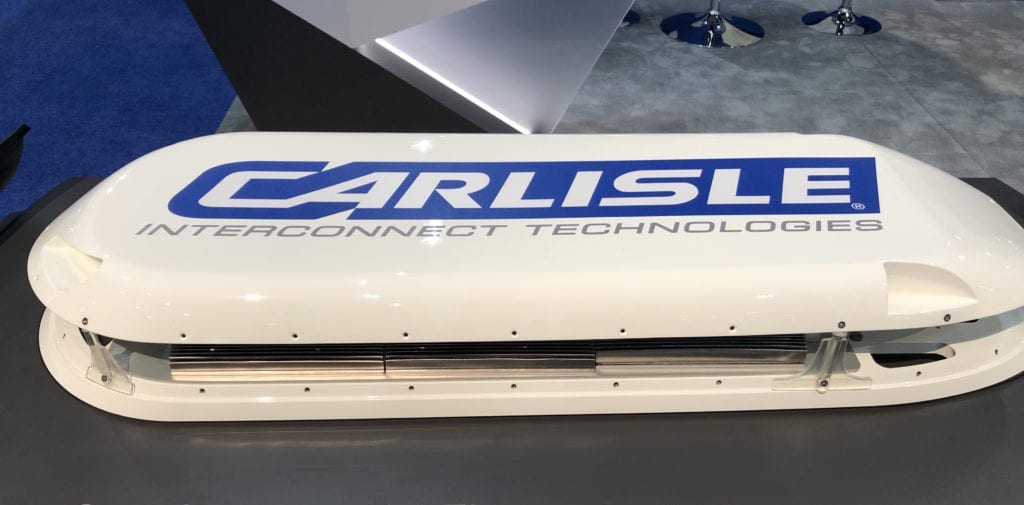
At the 2019 APEX EXPO, Carlisle Interconnect Technologies (CIT) signed a memorandum of understanding to bring a new satellite communications (SATCOM) antenna to the commercial aviation marketplace. The company displayed a prototype of a future radome and optimized cooling solution, pictured above, for a next generation electronically steered antenna.
LOS ANGELES – Carlisle Interconnect Technologies (CIT) and Ball Aerospace signed a memorandum of understanding at the 2019 Airline Passenger Experience Association (APEX) EXPO to bring a new cooling flow optimized integration package to electronically steerable antennas for future satellite constellations being developed by SpaceX, OneWeb and Amazon among others.
Under the new agreement, Carlisle will focus on providing the traditional materials it has provided such as antenna blind mate connections, coaxial and fuselage feed-thru connectors while leveraging Ball Aerospace’s experience supplying L, Ku, Ka and X-Band spectrum antennas across commercial and military operations.
“We’ve done some research and tapped into some satellite radiator technology to provide a very efficient heat transport system which gives us a nice uniform temperature plane underneath the electronics for beam steering and accuracy,” Jeff Behlendorf, director of product management, CIT, told Avionics International.
CIT’s role in the new partnership will include delivering a diverse global manufacturing footprint, aircraft integration and electronics packaging experience, and global airworthiness regulatory expertise both for new aircraft production and Supplemental Type Certificate (STC) retrofits.

Carlisle is incorporating some new design elements to optimize cooling for electronically steered antennas, as shown here in a simulation video they provided giving an overview of the design. Photo: Carlisle Interconnect Technologies
Behlendorf said ESA technology is nothing new, as it has been supported in military applications for decades, however it has not become widespread in commercial flight operations primarily due to development costs. Several antenna technology suppliers, including Phasor and Astronics, have electronically steerable antenna designs in various stages of development right now with a focus on reducing the profile and aerodynamic drag impact of the design on the fuselage.
“There are a lot of people launching satellite constellations right now you cannot support One Web or SpaceX’s promised cluster of satellites using a gimbaled antenna. The satellites go over the horizon every six minutes and you just can’t change satellites that quick with a gimbaled, you have to be able to track two at once, hand them off simultaneously and electronic antennas can solve that problem,” Behlendorf said.
CIT will leverage Ball’s second-generation of fully electronically steerable phased array antennas. These second-generation Ball antennas have been designed for commercial production using Ball Aerospace’s innovative sub-array antenna architecture, an electronically steerable flat panel array building block designed to be tiled with other sub-arrays to form a satellite communications terminal.

Further details on CIT’s antenna design. Photo: Carlisle Interconnect Technologies
Using a cooling flow optimized aerodynamic fairing and radome, as well as skirting and contact seal among other elements, Carlisle’s prototype design keeps cool air flowing through the radome to prevent overheating. Integrated ducted radiator channels create high and low pressure zones around the radome to drive flow through interior cooling channels, according to Carlisle’s simulation video showing the future design. Passive conduction and radiation is achieved while the aircraft is sitting on the ground with an integrated isothermal transfer plate.
The company transported a prototype of their next generation antenna design to APEX with a specific focus on the regional and business jet airline market, according to Kris Samuelson, director of in-flight entertainment and connectivity sales at CIT.
 | Want to hear more on aircraft connectivity applications? Check out the Global Connected Aircraft Podcast, where Avionics editor-in-chief Woodrow Bellamy III interviews airlines and industry influencers on how they’re applying connectivity solutions. |
“We plan to enter into hardware phase testing in November,” Samuelson said. “We’ve had some encouraging conversations at this show, there’s some aircraft flying lab type scenarios where there might be an opportunity to get aboard a flight test perspective. I think we’re already getting some exciting conversations going around it,” Samuelson said.
Carlisle is projecting a timeline of two years, in late 2021, for an introduction into service of the new antenna design.